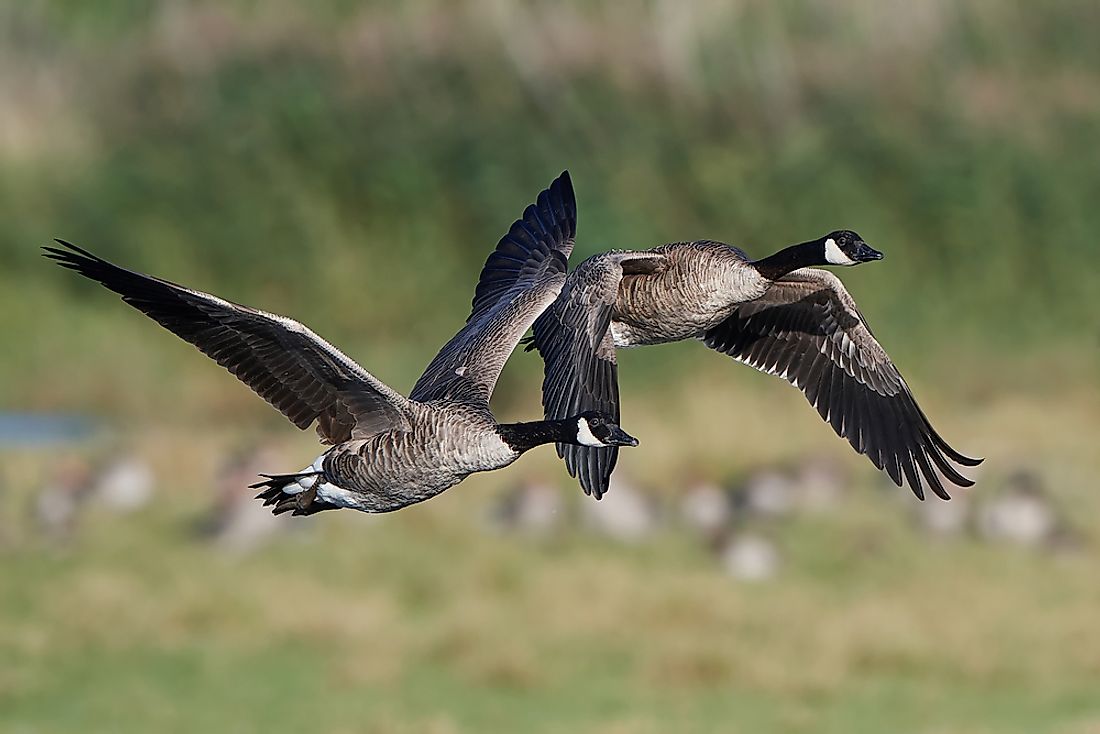Canada Goose Facts: Animals of North America

The renowned Canada goose, (Branta canadensis ) is a big wild goose species native to the temperate and arctic sites of North America. It sometimes migrates to North Europe. Like other wild geese, the Canada goose is mainly herbivorous and dwells close to fresh waters. It is highly adaptable and successfully thrives in human-altered areas. The goose is capable of establishing breeding colonies in cultivated and urban areas.
Physical Description
The Canada goose is distinguished from other geese species, as both its head and neck are black. It bears a white chinstrap. The area under its chin is white and it has white cheeks and a brown body. There are seven sub-species of the Canada goose. The species vary greatly in terms of plumage and size but they can all be easily identified as Canada geese. The smaller species can easily be confused with the cackling goose. However, the cackling goose has a smaller bill and a shorter neck. The Canada goose has a length range of 75 to 110 cm. It wingspan extends to 127 to 185 cm. The largest Canada goose ever recorded weighed 10.9kg. On average, the male Canada goose weighs between 2.6 kg and 6.5 kg. The females are slightly lighter and weigh between 2.4 kg and 5.5 kg.
Behavior
The Canada goose is migratory by nature just like other geese. As they migrate, the geese fly in a V-shaped formation and make loud calls. In the United States, hearing such migratory calls often signals transitions into either spring or autumn. Changes in habitats and food sources have caused a change in the migratory behavior of Canada goose. Some population of the Canada goose has become non-migratory due to lack of predators as well as adequate food supply during winter. Male geese exhibit agonistic behavior during breeding season and in nesting grounds. One such case was recorded when a male Canada goose attacked a brant goose that roamed his territory. The attack lasted for more than one hour until the brant goose died.
Habitat and Range
The Canada goose is native in North America and mainly breeds in a variety of habitats in northern United States and Canada. The greatest population of Canada geese is found in the Great Lakes region. Over hunting and loss of habitat in the early 19th century resulted to a serious decline of Canada geese in their native habitat. In fact, the giant Canada goose subspecies was considered extinct by 1950s. However, in 1962, a small flock of giant Canada geese subspecies was discovered in Rochester region in Minnesota.
With habitat recreation and improved game laws, Canada geese populations have recovered in most of their range. However, some species such as the B. c. occidentalis are still declining. Large populations of Canada geese have permanent residency in British Columbia, Chesapeake Bay, Triangle area of North Carolina, and Hillsborough. Canada geese also thrive areas such as Great Britain, Netherlands, Ireland,Finland, German, Scandinavia and Belgium among others.
Diet
Primarily, Canada geese are herbivores and mainly feed on grains and green vegetation. Sometimes, they feed on fish and small insects. The main grains that form the Canada goose's diet include corn, wheat, beans, and rice. While on land, the Canada goose feed on a variety of grass. It grasps the grass with the bill and tears it down by jerking its head. While on water, it feeds on a wide variety of aquatic plants.











